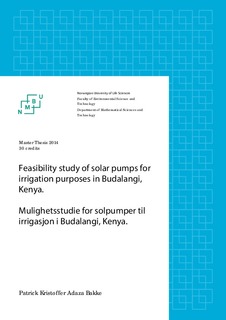| dc.description.abstract | The history of aid is a troublesome one. Despite the good intentions, the effort has often been in
vain. It has become apparent that sustainability in development projects are imperative. The purpose
of the study is the assess the feasibility of solar pumps for irrigation purposes in Budalangi, Kenya.
This study is not only looking if solar pumps are technological feasible, but it looks into other aspects
too. Such as economical feasible, environmental, social etc.
Budalangi is a flood-prone, poor, food insecure constituency in Kenya. Solar pump has been
suggested to help alliviate poverty and hunger.
The water quality in Budalangi varies a bit, some of the ground water is simply not possible to use for
agriculture. Out of 76 tests 7 found to have an EC of over 3 (dS/m). Which has an severe effect on
applicability of the water.
10 out of 76 test had an E. coli concentration of 200 CFU/100ml or more. Which is higher than the
strictest guideline. The microbial water quality does not effect the productivity thus it does not
receive a lot of attention.
The economical capacity for the farmer is insufficent for them to buy a solar pump without subsidies
or loans. It is also a completly unknown techonolgy to them, so some training is required. Luckily the
solar pump is low maintenance. In addition the producer of the solar pump is lacking in their capacity
to support buyers of the solar pump.
Despite the identified issues, the solar pump is a feasible technology for Budalangi. Long hours of sun
and available water are excellent conditions for the solar pump. A solar pump could potentially
increase the yield of a farm manifolds. It creates the opportunity to harvest during the dry season.
The demand for vegetables is high, 90% of the vegetables are imported from Uganda. Also with the
opportunity to sell crops out of season the income could also increase manifold. | nb_NO |
